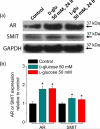Elevated extracellular glucose and uncontrolled type 1 diabetes enhance NFAT5 signaling and disrupt the transverse tubular network in mouse skeletal muscle
- PMID: 22966145
- PMCID: PMC3521620
- DOI: 10.1258/ebm.2012.012052
Elevated extracellular glucose and uncontrolled type 1 diabetes enhance NFAT5 signaling and disrupt the transverse tubular network in mouse skeletal muscle
Erratum in
- Exp Biol Med (Maywood). 2012 Nov 1;237(11):1368
Abstract
The transcription factor nuclear factor of activated T-cells 5 (NFAT5) is a key protector from hypertonic stress in the kidney, but its role in skeletal muscle is unexamined. Here, we evaluate the effects of glucose hypertonicity and hyperglycemia on endogenous NFAT5 activity, transverse tubular system morphology and Ca(2+) signaling in adult murine skeletal muscle fibers. We found that exposure to elevated glucose (25-50 mmol/L) increased NFAT5 expression and nuclear translocation, and NFAT-driven transcriptional activity. These effects were insensitive to the inhibition of calcineurin A, but sensitive to both p38α mitogen-activated protein kinases and phosphoinositide 3-kinase-related kinase inhibition. Fibers exposed to elevated glucose exhibited disrupted transverse tubular morphology, characterized by swollen transverse tubules and an increase in longitudinal connections between adjacent transverse tubules. Ca(2+) transients elicited by a single, brief electric field stimuli were increased in amplitude in fibers challenged by elevated glucose. Muscle fibers from type 1 diabetic mice exhibited increased NFAT5 expression and transverse tubule disruptions, but no differences in electrically evoked Ca(2+) transients. Our results suggest the hypothesis that these changes in skeletal muscle could play a role in the pathophysiology of acute and severe hyperglycemic episodes commonly observed in uncontrolled diabetes.
Figures









Similar articles
-
Activity- and calcineurin-independent nuclear shuttling of NFATc1, but not NFATc3, in adult skeletal muscle fibers.Mol Biol Cell. 2006 Apr;17(4):1570-82. doi: 10.1091/mbc.e05-08-0780. Epub 2006 Jan 25. Mol Biol Cell. 2006. PMID: 16436503 Free PMC article.
-
MEF2 activation in differentiated primary human skeletal muscle cultures requires coordinated involvement of parallel pathways.Am J Physiol Cell Physiol. 2004 Jun;286(6):C1410-6. doi: 10.1152/ajpcell.00444.2003. Epub 2004 Feb 11. Am J Physiol Cell Physiol. 2004. PMID: 14960415
-
Acute Elevated Glucose Promotes Abnormal Action Potential-Induced Ca2+ Transients in Cultured Skeletal Muscle Fibers.J Diabetes Res. 2017;2017:1509048. doi: 10.1155/2017/1509048. Epub 2017 Aug 1. J Diabetes Res. 2017. PMID: 28835899 Free PMC article.
-
NFAT activation by membrane potential follows a calcium pathway distinct from other activity-related transcription factors in skeletal muscle cells.Am J Physiol Cell Physiol. 2008 Mar;294(3):C715-25. doi: 10.1152/ajpcell.00195.2007. Epub 2008 Jan 9. Am J Physiol Cell Physiol. 2008. PMID: 18184878
-
Parallel mechanisms for resting nucleo-cytoplasmic shuttling and activity dependent translocation provide dual control of transcriptional regulators HDAC and NFAT in skeletal muscle fiber type plasticity.J Muscle Res Cell Motil. 2006;27(5-7):405-11. doi: 10.1007/s10974-006-9080-7. Epub 2006 Jul 28. J Muscle Res Cell Motil. 2006. PMID: 16874450 Review.
Cited by
-
Alternating bipolar field stimulation identifies muscle fibers with defective excitability but maintained local Ca(2+) signals and contraction.Skelet Muscle. 2016 Feb 5;6:6. doi: 10.1186/s13395-016-0076-8. eCollection 2016. Skelet Muscle. 2016. PMID: 26855765 Free PMC article.
-
Disruption of action potential and calcium signaling properties in malformed myofibers from dystrophin-deficient mice.Physiol Rep. 2015 Apr;3(4):e12366. doi: 10.14814/phy2.12366. Physiol Rep. 2015. PMID: 25907787 Free PMC article.
-
NH4Cl Treatment Prevents Tissue Calcification in Klotho Deficiency.J Am Soc Nephrol. 2015 Oct;26(10):2423-33. doi: 10.1681/ASN.2014030230. Epub 2015 Feb 2. J Am Soc Nephrol. 2015. PMID: 25644113 Free PMC article.
-
Elevated nuclear Foxo1 suppresses excitability of skeletal muscle fibers.Am J Physiol Cell Physiol. 2013 Sep 15;305(6):C643-53. doi: 10.1152/ajpcell.00003.2013. Epub 2013 Jun 26. Am J Physiol Cell Physiol. 2013. PMID: 23804205 Free PMC article.
-
NFAT5: a stress-related transcription factor with multiple functions in health and disease.Cell Stress. 2025 May 22;9:16-48. doi: 10.15698/cst2025.05.304. eCollection 2025. Cell Stress. 2025. PMID: 40421201 Free PMC article. Review.
References
-
- Crabtree GR, Olson EN. NFAT signaling: choreographing the social lives of cells. Cell. 2002;109(Suppl):S67–79. - PubMed
-
- Rao A, Luo C, Hogan PG. Transcription factors of the NFAT family: regulation and function. Annu Rev Immunol. 1997;15:707–47. - PubMed
-
- Ko BC, Turck CW, Lee KW, Yang Y, Chung SS. Purification, identification, and characterization of an osmotic response element binding protein. Biochem Biophys Res Commun. 2000;270:52–61. - PubMed
Publication types
MeSH terms
Substances
Grants and funding
LinkOut - more resources
Full Text Sources
Medical
Miscellaneous

